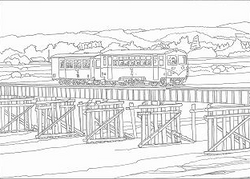
Business content
▶ ︎Mikkel Art
▶ ︎Mural painting
▶ ︎Design drawing production
▶ ︎ Coloring book for the area
 |
|---|
 |
 |
 |
 |
What is a regional coloring book?
Local coloring books are local coloring books that make you feel nostalgic about local festivals and famous places . There are currently about 50 series .
The road to completion of "Regional Coloring Book"
We planned this project together with an occupational therapist with the aim of "energizing elderly people with reduced motivation and elderly people suffering from dementia." When we talked to the elderly who actually use the facility, they all cherished their memories of their hometown. Taking inspiration from that feeling, he devised a coloring book based on the scenes that elderly people feel "nostalgic" -playgrounds as a child, festival scenery, etc.-and co-supervised with occupational therapist Dr. Usami. It was commercialized in 2012.
Coloring book of the area seen from the occupational therapist (Occupational therapist Yoshihiro Usami)
There is an idea of occupational therapy that "people can get better by working". However, the work is not all right. The work can only be energetic if it is meaningful and valuable to the person. What is meaningful and valuable work for me? I don't think there are many people who can answer quickly when asked. Human work is connected to the past, present and future. There is a past and now. There is now and it continues to the future. Looking back on the past, I now realize what I value, what is meaningful and valuable. I thought this was important. You can also notice the background (reason).
By performing reminiscence while coloring the area, meaningful work and valuable work are verbalized. Then, the work you want to do, which was at an unconscious level, becomes conscious. If you make it clearer and make a plan so that you can do it concretely, you will be able to act independently.
Features of "Regional Coloring Book"
Local coloring books come with "a sample of nostalgic coloring books" and "explanatory text that shows the background and context of the era." This is expected to help the elderly to recollect familiar areas and heal their minds.
1. With a nostalgic coloring book sample
The colorfully drawn sample not only functions as a sample, but also reminds you of a nostalgic landscape just by looking at it and heals your heart.
2. A descriptive text that shows the background and context of the era
Below the picture, the background and context of that era are explained. Even if there is a picture of an area you do not know, this explanation can encourage the subject to speak and facilitate communication.
How to use "Regional Coloring Book"
Local coloring books can be used in various ways depending on the way of thinking. Here, I would like to introduce one of the practical methods that I am using. First, look at a sample coloring book of the area that you are familiar with. Then, while reading the explanation that shows the background and context of the era together, ask the target person to tell us about the area depicted in the sample.
When the subject is immersed in the memories of the area and becomes interested in it, he or she will start coloring. At first, we will do it together during occupational therapy, but gradually you will have to do it yourself at times other than occupational therapy.
Put the finished coloring book in your frame and decorate it in your room. And when there is an event such as Keirokai, we will exhibit it so that many people can see the work. By developing the work of coloring in this way, we will create tension in the lives of the target people and make their daily lives enjoyable and healthy.
I use the task of coloring as a tool to keep people healthy. Please make use of it for long-term care workers as well. The above is partly quoted from Professor Usami's column (September 24, 2012)

Sensei Yoshihiro Usami
[Affiliation] Teikyo Heisei University Faculty of Health and Medical Sciences Occupational therapy department Assistant professor
[Current academic society] Japan Occupational Therapists Association, Tokyo Occupational Therapists Association
[Research Fields] Occupational Therapy for Physical Disabilities, Occupational Therapy for Geriatric Disabilities, Collaboration between Professionals
[Main research items] Research on collaboration between occupational therapists and long-term care workers in special nursing homes for the elderly
The effect of recollection
In a basic study of eight adult females using Mickel Art, four people felt that they were "relaxing," "lively," "energetic," and "lively" when they saw the picture.
The left cerebral blood flow changed by 0.22 mM-mm and the right by 0.24 mM- mm when these four people saw the painting, while the other four people who did not feel anything when looking at the painting left- It was 0.1 mM-mm0 and left-0.09 mM-mm. There was no difference in the total number of gazes and the number of gazes for 0.2 seconds or more, but there was a difference in the way of looking at the eye movements. The four people who felt comfortable gazed at a particular place in the painting for significantly longer.
In addition, the number of characters and items in the free description was also seen by many people who felt comfortable with the picture.
From this result, it became clear that the cerebral blood flow is increased and the number of characters in the narrative is increased by paying close attention to the painting and remembering and remembering something. It has been suggested that consciously providing paintings that incorporate information that the subject likes and effectively inducing gaze lead to brain function activity.
Click here for regional coloring books (click the logo below)

